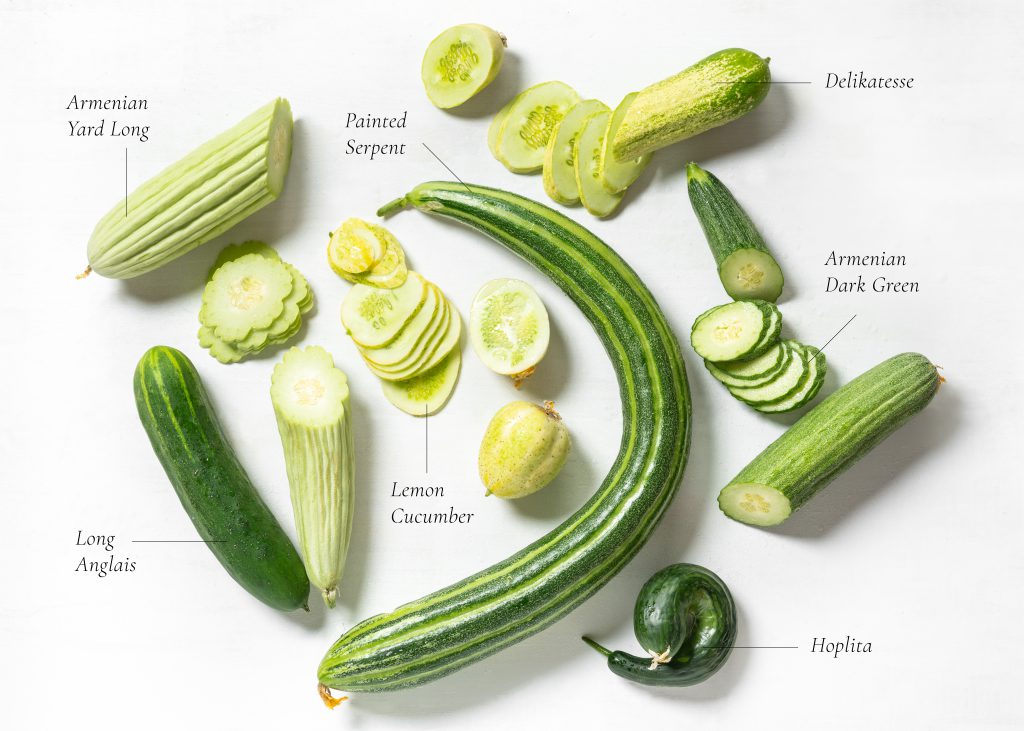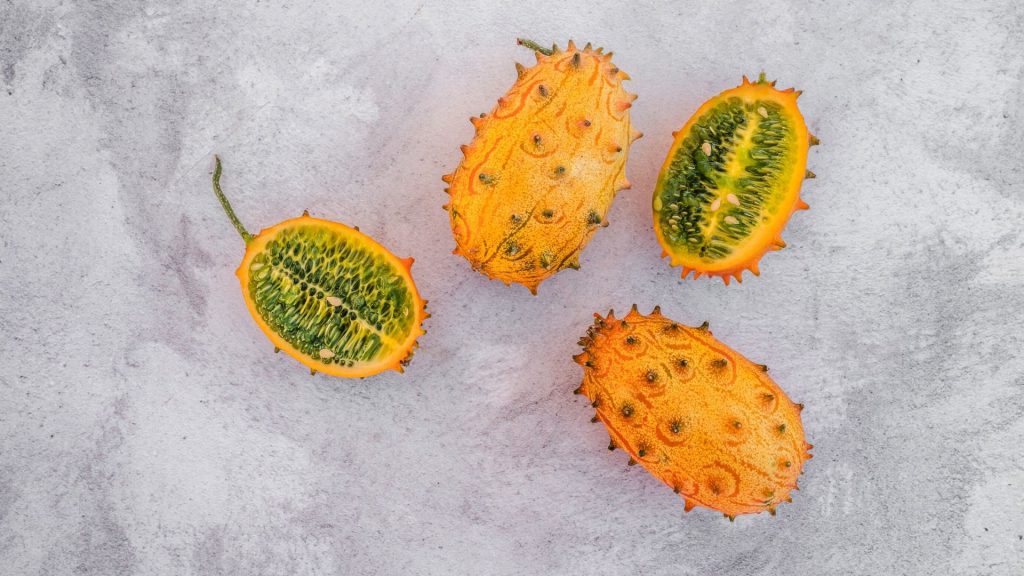
Restaurants
Spa
Day Visits
Shop
Functions
16°C
February 17th, 2022
There’s a rustle in the new tunnels at Babylonstoren where the finest heirloom cucumbers are stretching up their rambling arms and bearing the most unusual fruit. Some are minty green and crinkle-cut with a crispy crunch, while others curl on the ground to create serpent-like shapes with striking striped skins.

Cucumbers are believed to have originated in India, where cave excavations indicate that they have been grown as a food source for more than 3000 years. But they weren’t always the juicy-sweet crunch bombs we know and love today. Early cucumbers contained a high dose of cucurbitacin – a very bitter natural defence compound that repels insects and other pests. Today still, bitterness is a problem with some cucumber varieties, although great progress has been made by plant breeders to eliminate the bitter compounds.
In our new heirloom tunnels, however, we are taking a step back and growing these non-commercial varieties from scratch again to use in our kitchens and fresh produce offerings. Bitter is a flavour, we like to think, and a vital element in our collective modern palate. Think of foods like rocket leaves with their spicy tang, a crunchy radish, a cup of strong black espresso or a zingy gin & tonic with its characteristically bitter bite, and even our Babylonstoren bitterlekker non-alcoholic aperitif. Perhaps our pungent cucumber ancestors were a little misunderstood during previous centuries …
So, we’re giving them another place in the sun with room to grow and are discovering how to celebrate their unique and alternative qualities, textures and tastes. Here are some of our favourite heirloom varieties, plus a few ideas on how to best utilise them.

This beautiful cucumber has a gorgeous green colour and a ribbed texture, which gives it a scalloped edge that looks like a flower when cut diagonally. The Yard Long has a soft sage colour compared to the Dark Green Armenian. Inside, they have a firm, dense texture that delivers a super crunch for salads. The taste is sweet and mild, even fragrant. Thanks to the lower water content in these versatile cuces, they are good for braaiing or grilling and sautéing, and can also be pickled.
◗ On a sharp diagonal, cut the cucumber into 5 mm slices. Braai on a warm fire and turn with tongs. Place on a platter, sprinkle with a little salt and drizzle with a little lemon juice. Chop fresh mint and scatter over. Serve with plain yoghurt as a dip or serve as a side dish with lamb, fish or chicken.
◗ Sauté strips with chillies, garlic and a protein of your choice, and serve with Thai noodles and sesame seeds.
◗ Blend in a food processor with garlic, lemon juice, salt and black pepper to taste. Whip with some ricotta cheese or chunky cottage cheese. Serve with warm crusty bread or in a pasta salad.
◗ Use a juice extractor and add cucumber, apple, celery and green cabbage leaves for a healthy kickstart in the morning.
A green and white striped cucumber with a name fit for a goddess! These interesting ramblers grow and curl into snake-like shapes. The taste is mild and delicious. They do not need to be peeled, but it’s best to remove the fuzz with a soft vegetable scrub brush before eating.
◗ Fattoush – a Middle Eastern recipe with chopped tomato, red onion, chopped Italian parsley, mint leaves, crushed garlic, olive oil, lemon juice, salt, black pepper and, of course, loads of crunchy cucumber. Serve with freshly fired pitta bread chunks tossed through.
◗ Great for making a cool summer soup.
◗ Use to make your favourite pickle. The striped skin makes for an interesting final product.
This easy-to-grow cucumber was developed in the Netherlands. It’s a fast and easy grower with a mildly sweet taste.
◗ Make a simple salad with sliced, unpeeled cucumber, red onion, a little crushed garlic and fresh chopped parsley, dill or coriander.
◗ Serve as a pickled accompaniment to Asian dishes. Use cucumber ribbons and add rice wine vinegar, grated fresh ginger, chilli flakes and sprinkle with toasted sesame seeds and a small drizzle of sesame oil.
◗ Great to use in sushi!
This German variant is super tasty with a slightly citrusy taste. It’s great for pickling. The skin is covered in little warts, and the inside is lovely lime green.
◗ Leave the skin on for this favourite German recipe. Slice the cucumber any way you like and marinate for a few hours with a dash of cider vinegar. Strain and add sour cream, thinly sliced onion, chopped fresh dill and parsley and a pinch of paprika. Toss lightly. You can replace the sour cream with yoghurt. You can add sliced tomato and a little Dijon mustard to the recipe if you like.
◗ A typical ingredient list for German pickles includes equal amounts of water and vinegar, salt, sugar, garlic, dill, bay leaves, horseradish, mustard seeds, black peppercorns and juniper berries.
This beauty gains its name from imitating a lemon. Although round and yellowish in colour, it has no lemony taste. It has a mild, sweet and cool taste. The skin is slightly thicker with a bitter undertone, and the centre contains many juicy seeds.
◗ The perfect garnish for gin & tonic, combining the qualities of cucumber and lemony looks, with a bitter undertone to complement the gin.
◗ Ideal for a snack. Cut them in wedges; if they are young, you can leave the skin intact. Serve with a bowl of pesto to dip in.
◗ Great for making great-looking pickles. Slice into wedges and add sliced onion and red sweet pepper in a pickling jar. Make a pickle of vinegar, sugar, garlic, celery seeds, mustard seeds, dried dill seeds, pickling spice and salt.
◗ Eat it like an apple with a little salt or toasted sesame seeds.
◗ Slice into halves and grill on a barbeque or in a griddle pan. Season with salt and freshly ground black pepper. Drizzle with a little olive oil, balsamic vinegar and shaved parmesan cheese.
◗ Great to add to lemon water.
This peculiar fruit is also known as horned melon, African cucumber, kiwano or blowfish fruit. The spiky skin varies in colour from dark green to orange-yellow and isn’t edible. Inside, the flavour is a cross between cucumber, zucchini and kiwi fruit. The flesh is a jelly-like green, full of edible seeds. Be sure to remove the sharp points of the outside horns before working with them, as these cuties bite!
◗ Great scooped out on fresh oysters with grated fresh horseradish or just a dash of Tabasco.
◗ Add as a top layer on a cucumber-friendly cocktail or aperitif.
◗ Serve frozen on a hot summer day, as a palate cleanser between meals.

This delicious orb-shaped cucumber’s character lies in its round shape and sweet, grassy, mild flavour and juiciness. It can literally be eaten like an apple and the skin is thin and sweet.
◗ Best eaten raw as is.
◗ Great to serve sliced in quarters as an appetiser with drinks.
◗ Makes a great salsa with Granny Smith green apple and served on the side with any curry. You can add yoghurt if you like.